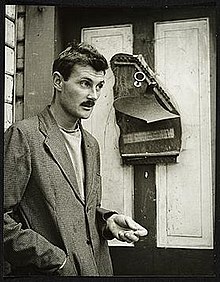Morris Graves
| Morris Cole Graves | |
|---|---|

Morris Graves, 1938. Photo by Robert Bruce Inverarity. Archives of American Art, Smithsonian Institution
|
|
| Born |
August 28, 1910 Fox Valley, Oregon |
| Died | May 5, 2001 (aged 90) Loleta, California |
| Nationality | American |
| Known for | Painting |
| Movement | Abstract Expressionism, Northwest School |
Morris Graves (1910–2001) was an American painter. He was one of the earliest Modern artists from the Pacific Northwest to achieve national and international acclaim. His style, referred to by some reviewers as Mysticism, used the muted tones of the Northwest environment, Asian aesthetics and philosophy, and a personal iconography of birds, flowers, chalices, and other images to explore the nature of consciousness.
An article in a 1953 issue of Life magazine cemented Graves' reputation as a major figure of the 'Northwest School' of artists. He lived and worked mostly in Western Washington, but spent consbird with offsring iderable time traveling and living in Europe and Asia, and spent the last several years of his life in Loleta, California.
Morris Cole Graves was born August 28, 1910, in Fox Valley, Oregon, where his family had moved about a year before his birth, from Seattle, Washington, in order to claim land under the Homestead Act. He was named in honor of Morris Cole, a favored minister of his Methodist parents. He had five older brothers, and eventually, two younger siblings.
Constant winds and cold winters made it much more difficult than expected to establish a working farm, and the struggle led to bankruptcy of the senior Graves' once-thriving paint and wallpaper store in Seattle. In 1911, a few months after Morris' birth, the family returned to the Seattle area, settling north of the city in semi-rural Edmonds, Washington.
He was a self-taught artist with natural understandings of color and line.
Graves dropped out of high school after his sophomore year, and between 1928 and 31, along with his brother Russell, visited all the major Asian ports of call as a steamship hand for the American Mail Line. On arriving in Japan, he wrote:
There, I at once had the feeling that this was the right way to do everything. It was the acceptance of nature not the resistance to it. I had no sense that I was to be a painter, but I breathed a different air.
In his early twenties, Graves finished high school in 1932 in Beaumont, Texas, while living with his maternal aunt and uncle. He then returned to Seattle, and received his first recognition as an artist when his painting Moor Swan (1933) won an award in the Seattle Art Museum's Northwest Annual Exhibition and was purchased by the museum. He split his time between Seattle and La Conner, Washington, where he shared a studio with Guy Anderson. Graves' early work was in oils and focused on birds touched with strangeness, either blind, or wounded, or immobilized in webs of light.
...
Wikipedia
